What Goes Around… A Tribute
WHAT GOES AROUND
It was the strangest thing. Sometime after the CCC article on the funky Conquistadors club plaque, Rik Hoving sent me this:
“Hello, Larry. I got this email. Thought you would enjoy it.”
A lady in North Carolina contacted Rik Hoving in the Netherlands, to reach me in Montana! What could this be about?
Turns out, a LOT!
“My sister and I are the daughters of Cecil Wentz. She has pictures of the car that our father built that she would like to share…” The very roadster that had been the inspiration for that club plaque!
I sat dumb-struck, marveling at the powers of the WorldWideWeb. Then, I had a flashback. I was a kid, learning the water tricks of irrigation. Orey Talbert was boss farmer, a gnarly old cowboy from the old school of hard knocks. We were standing at the edge of a pond. He threw a rock. It hit the still water with a “plunk”. We silently watched as rows of ripples flowed out to the far shores, and back again.
“What goes around,” Orey rasped, taking a drag on his hand-rolled Bull Durham cigarette, “comes around.”
“If you do good, good comes back to you.”
Ripples on a Pond! From the Netherlands, across the Atlantic Pond, Rik Hoving has done just that! I’d like to share this one ripple with the CCC, but first, one fan’s tribute to Rik Hoving.
It was with the summer issue, No. 33, of The Rodder’s Journal in 2006 that I first became aware of Rik Hoving. “Kolorized Kustoms” appeared on the cover list of articles. I turned to page 26, “Classic Customs AS You’ve Never Seen Them”. I was blown away. Here were the classic images, the b/w prints we’d seen in the “little pages”, but digitally reproduced in full color! “Hot Rod and Custom Show in Los Angeles 1954” revealed not just the cars of the show lot, but the entire street scene beyond, all in period perfect color!
 Two spreads of the Kolorized Kustoms article in the Rodder’s Journal issue 33.
Two spreads of the Kolorized Kustoms article in the Rodder’s Journal issue 33.
[divider]
And that’s not all, this Rik Hoving from the Netherlands identified each and every car in the show, right down to the far left lower corner, barely showing the front fender of the Louie Bettancourt 50 Mercury!
Who was this guy, Rik Hoving? Once I could tear my eyes away from his digital magic, I read his answer:
“Though I was born in 1967 and am too young to have seen these cars drive on the streets, I fell in love with customs when I was about 15 years old. Growing up and living in the Netherlands made it a bit harder for me to discover the fantastic history of custom cars…but I amassed a great collection of old custom car magazines and books, and the more I found out about these custom cars and their creators the more fascinated I became.”
Hey! Rik Hoving was just like all of us, bitten with the passion bug for which there is no cure. All across the land, how many of us stared in awe at these marvels in black and white, and could only imagine “colors like Bertolucci Maroon, Scintillating Green Gold, and deep lacquer paint jobs with gold powder for extra sparkle.”
”Somehow,” Rik explained, “I could see these colors hiding amongst the gray scales of the black and white photos.”
And has empowered others to see! By dropping that first “rock”, Rik Hoving created ever expanding ripples of friends and followers, over the Atlantic “Pond.” His fascination with the photographic treasures of traditional custom cars led to the online “Rik Hoving Photo Gallery,” creating even more ripples, as enthusiasts began to open their old albums and share their collections. Then, two years ago, Rik launched Custom Car Chronicle to rave reviews. And an astounding swell of followers.
“If you do good, good comes back to you.” Good on you, Rik Hoving.
Cecil Wentz
Where was I? Oh, how did that lady, Cecil Wentz’s daughter Beverly, far and away in North Carolina, come to find customcarchronicle.com? It was her sister Cecelia who would answer:
“My son Joe in Loveland, Colorado, told me about an article he saw that mentioned dad as a mentor. I hadn’t a chance to look for it, when a few days later, Beverly sent me the article that her son had found.” She failed to locate me. “So I told Beverly and she found you through the Netherlands site.”
Pretty soon emails were flying across the web. Turns out both the sisters’ sons, like grandfather, were car guys. What’s the old saying? The apple doesn’t fall far from the tree.
But Cecil Wentz’s daughters had no idea their dad had made indelible impressions on our generation of Conquistadors. Wyoming winters took their toll on Cecil’s arthritis and in 1957 the family relocated to sunny San Diego, California. There he found mechanic work in the Pontiac dealership and, for a few years, continued racing sprint cars. Back in Sheridan, lawyer Birchby opened the Wentz shop to Harry Schwartz and the Conquistadors. It was Harry who finally would score the treasured robin’s egg green roadster that Cecil Wentz had built; the roadster that became the model for our car club plaques cast in the high school shop.
 Cecil Wentz posing with his home made roadster in black primer before he painted it robin’s egg green.
Cecil Wentz posing with his home made roadster in black primer before he painted it robin’s egg green.
[divider]
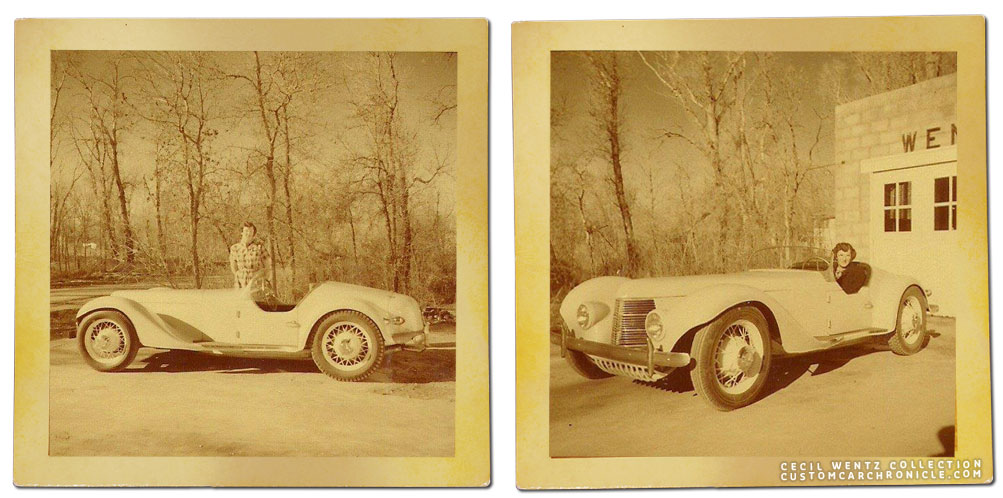
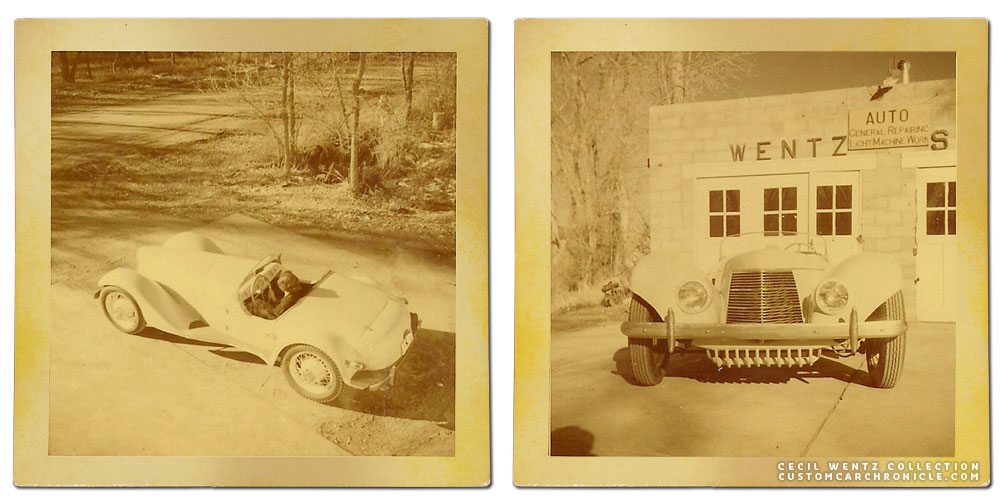 A couple of badly faded color photos of the roadster with Cecil’s wife and in front of the Wentz shop.
A couple of badly faded color photos of the roadster with Cecil’s wife and in front of the Wentz shop.
[divider]
Then, there they were: scanned images of that all-important sporty roadster. It was like nothing before or since, a one-off creation of the 50s. What had Cecil Wentz drawn from to form this iconic car? Harry Schwartz said the chassis came from a wrecked 32 Ford sedan. The tail-lights he’d identified as 36 Hudson. That figured. Cecil’s sprint car, it said in a local newspaper Beverly sent, ran a 36 Hudson six, and I’d spotted just such a car parked outside their shop in another photo.
 The body on Cecil’s roadster was partly hand formed and he had used parts of a 1938 Studebaker for the grille,hood and feners.
The body on Cecil’s roadster was partly hand formed and he had used parts of a 1938 Studebaker for the grille,hood and feners.
[divider]
Much of the body was hand-formed, with a European sports car dip in the doors. The odd trunk certainly could have been borrowed and cut down from that same Hudson. Fenders definitely were Ford. The fronts were cut away for a sportier look, then skirted; the rears were welded and leaded onto the body. Beverly recalled that their uncle Joe Labay had helped Cecil with the welding.
But that distinctive grille and hood line had to have been borrowed from a different 1930s automobile. Finally, I found it: a 1938 Studebaker President had been the donor of those parts. And the frenched-in headlight pods could have been scrounged from the same salvage yard.
“I remember the car as a light green,” Beverly noted. Early shots also show it in black primer.
What a shame Dick Baldwin scooped up some free range critters and destroyed the feisty face of this iconic innovation. But, now thanks to Rik Hoving and the sisters Wentz, we all can see what an attitude that roadster brought to the Sheridan scene.
 Wentz Carburetor Special sprint car with the special “W” in the grille.
Wentz Carburetor Special sprint car with the special “W” in the grille.
[divider]
 Sadly these color photos are also badly faded, however we can see a little bit of the orange color on this Number 3 racer in these photos.
Sadly these color photos are also badly faded, however we can see a little bit of the orange color on this Number 3 racer in these photos.
[divider]
Several Sheridan scenes had been saved by Cecelia and Beverly. Their dad had passed away in 2000, but the ladies kept images of their childhood. And now, are passing them along: There were photos of Cecil and his orange Number 3 Wentz Carburetor Special sprint car in the drive to his shop in 1954. In the background could be seen his second dirt track passion, a stock car from the day we called them jalopy racers. Then came the most moving of the images, a crystal clear shot of the interior of that shop! Here, he had built that roadster. Here, also the sprint car and its country cousin jalopy. Here also, the carburetor for that Hudson engine sitting front and center on the floor in the garage scene.
The Wentz Carburator
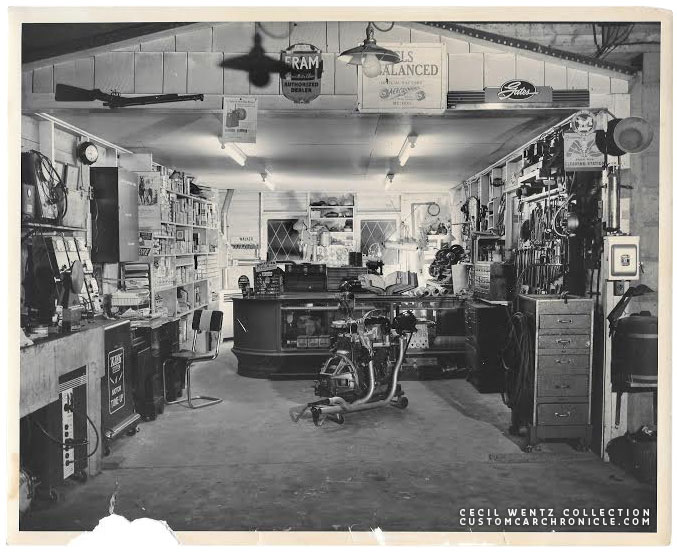 This photo must have been taken by a professional photographer. It shows the Cecil’s wonderful shop.
This photo must have been taken by a professional photographer. It shows the Cecil’s wonderful shop.
[divider]
 The engine in the shop photo is an 1936 Hudson Terraplane block that Cecil worked on.
The engine in the shop photo is an 1936 Hudson Terraplane block that Cecil worked on.
[divider]
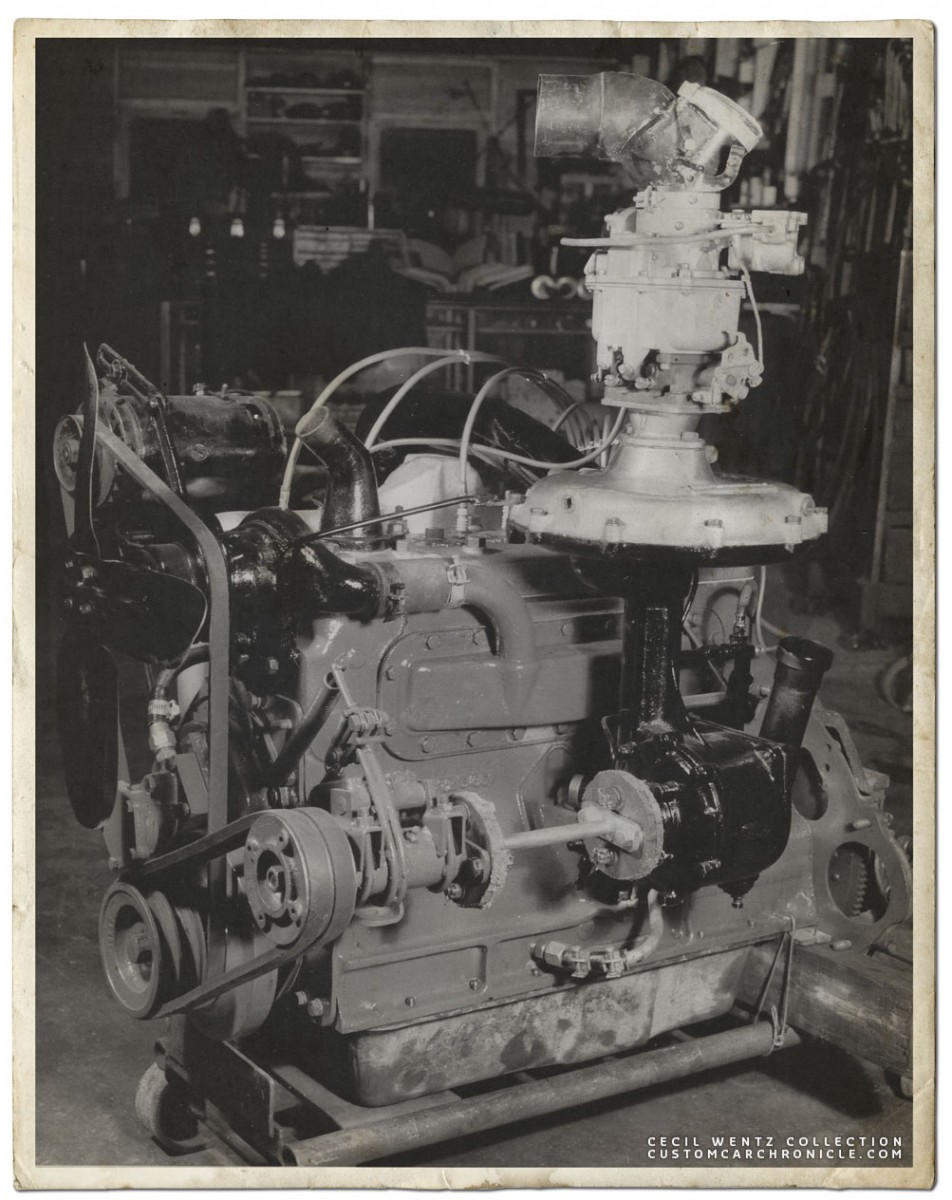 The other side of the engine shows the Graham supercharger and the Wentz carburetor on top of it.
The other side of the engine shows the Graham supercharger and the Wentz carburetor on top of it.
[divider]
The Sheridan papers closely followed developments in the Wentz garage. “For power, Wentz started with a 1936 Terraplane block, but you hardly recognize it as such, he has made so many additions and refinements. And inside it, some significant changes have been made. For one thing, it is polished internally and works as smoothly as about any high-priced, high-powered engine you’ll ever see. It has to work smoothly, since it will turn up to as high as 6200 revolutions per minute…. It develops more than twice the horsepower it did as a stock model—“in excess of 200 horsepower at 5100 revolutions per minute,” according to its owner.”
“A (Graham) supercharger mounted on the engine increases its total power considerably, giving, as Wentz puts it, “greater push to the pistons.” The girls told me a story of the carburetor Wentz had designed, machined, and performance tested to perfection. Beverly thought it a fuel injection design. As details emerged, he had worked out a means of achieving both fuel feed for low end acceleration, and variously, for flat-out high-end performance.
 Close up of the carburetor Cecil developed.
Close up of the carburetor Cecil developed.
[divider]
“It is the carburetor mounted atop the supercharger that is the pride and joy of Wentz,” the Sheridan Press reported. “It alone gives the engine between eight and 10 per cent more power, he reports.”
“Carburetion is extremely difficult on ‘hopped-up’ cars,” Wentz explains, “But it is even more difficult to work out for low as well as high speeds.”
“This carburetor, all hand-built in Wentz’ shop, was designed by its owner for maximum performance—not just at high, racing car speeds, but for lower speeds as well. He has attempted to develop a carburetor that will work under traffic conditions and give the driver more snap when he wants or needs it.”
“His, developed and patented as a multi-purpose carburetor, gives greater flexibility since it has proven to work well at high and low speeds, he declares.”
“As he explains it: “It will work efficiently at speeds ranging from five miles per hour to 120 miles per hour in high gear—in high gear, mind you.” He added: “I defy anyone to match that performance.”
“It works on an old theory, but it’s on a new structure—an improvement on an old conventional carburetor,” he said.
“The principle is that of a variable venture—that is, the carburetor varies the amount of air and fuel demanded by the engine. As worked out by Wentz, the gadget gives close to perfect vaporization.”
 Pattent drawings of Cecil’s Carburetor.
Pattent drawings of Cecil’s Carburetor.
[divider]
When Beverly sent me the patent papers and drawings, she wrote that he had become discouraged and eventually let the patent lapse. “Mom and us kept telling him to renew it when it was going to expire. I guess he figured no one would want it.” To his chagrin, Ford Motor Company immediately took up the patent. “Boy did he ever get angry.”
“I know exactly what you are talking about,” Conquistador Dick Holcombe smiled as I babbled all this to him. “They called it a variable venturi carburetor. Ford had it for awhile, til they came up with something better. They were a bear to work on. Took special tools. And I still have ‘em,” he grinned.
From that point in his life, there never would be a Ford in Cecil Wentz’s future. “He hated Fords after that,” Beverly recalled. “Now I will throw some of the sick Wentz humor on you. First of all he died January 4, 2000. My sister said Dad just wasn’t Y2K compatible. Wasn’t long after she called me and said, ‘Well, Dad just turned over in his casket. I just bought a Ford truck!’ Anyway to be a Wentz you have to have humor good or bad.”

Among the memorabilia in the care package Beverly Wentz sent was the 1946 booklet, “Automobile Racing, sixth edition by Ray F. Kuns, chock-full of “how-to” articles for die-hard gearheads. But another Clymer Publication really caught my eye. It was dog-eared from use, and, like the first, had one corner burnt from sitting too close to fabrication work in the Wentz shop. “How to build a Racing Car”, by K. J. Domark. Inside, with drawings to illustrate, was a section on how to build a sprint car nose from the back halves of a square-topped early 30s sedan body:
The Radiator Shell
 How to build a racing car showed how you could create a track-nose from sections of the sedan body from the early 1930’s.
How to build a racing car showed how you could create a track-nose from sections of the sedan body from the early 1930’s.
[divider]
“A neat well-made professional-looking radiator shell adds much to the appearance of a racing car. It is quite a job to hammer out a shell from a piece of sheet metal even for an experienced man. However, there is a way that a satisfactory shell can be fabricated if you have a little sheet metal experience and can weld. An attractive shell for either a midget racer or a dirt track job can be assembled from the two top rear corners of an old model automobile body. (Fig. No, 16). These corner sections must have the proper contour. If the two corners are cut out completely, and then butted together and welded longitudinally (at dotted lines A and B), the basic shell will be formed. It will then be necessary to cut out the opening for the grill. This can be circular, oval, heart-shaped or almost any selected design.”
Wow! George Barris, eat your heart out! Here in a 1949 Floyd Clymer racing publication, available at news-stands for $2, were “how-to” customizing articles. Early racing and traditional custom car roots were inextricably intertwined. The “something borrowed” maxim was widespread in the Post-War years. Fabrication skills…making something out of seemingly nothing…trace to those lean times in myriad ways. It made me ponder. Did the nose for the ” Wentz Carburetor Special, No. 3” come from the rear of that same wrecked 1932 Ford sedan that had donated its chassis and running gear to our Conquistador roadster? Sifting through these materials was giving me deeper appreciation for the ingenuity of our mentor, Cecil Wentz.

Miniature true to scale tools, engines and cannons.
“You probably remember the miniature true to scale tools my Dad made,” Bevery added. “He had them framed in the shop. Our daughter still has the building sign, Wentz Auto and Machine Shop. Dad started building miniature full race engines (RC compatible) after he retired in about 1975. He made quite a few and they are divided among the kids and grandkids. He made us promise never to run them!!! DUH, like we would have known what to do!!! He was featured in a magazine for those.”
 The shop wall showing the framed miniature tools and a few of the miniature engine he made.
The shop wall showing the framed miniature tools and a few of the miniature engine he made.
[divider]
 Memorabilia wall in the shop.
Memorabilia wall in the shop.
[divider]
 One of the miniature engines taken apart.
One of the miniature engines taken apart.
[divider]
 The miniature engine Cecil created all worked.
The miniature engine Cecil created all worked.
[divider]
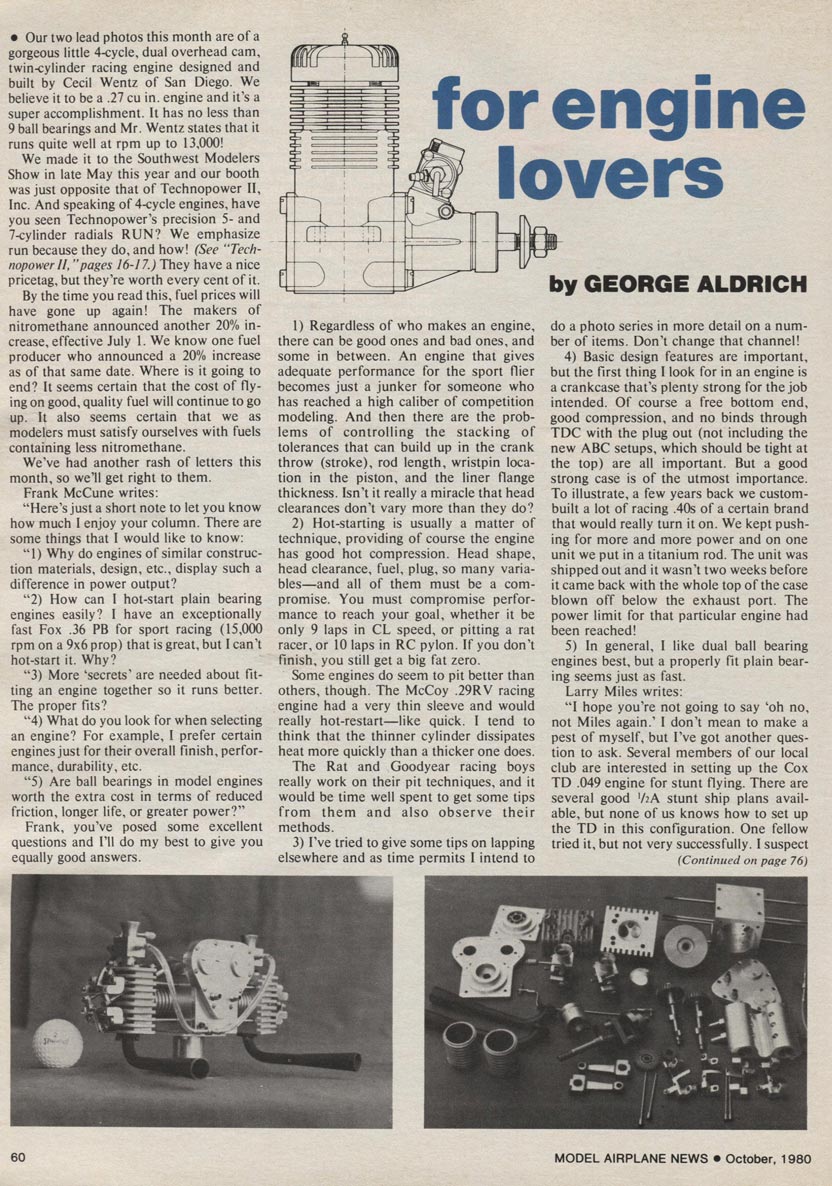 Article on the engines Cecil created in the October 1980 issue of Model Airplane News magazine.
Article on the engines Cecil created in the October 1980 issue of Model Airplane News magazine.
[divider]
Sure enough, there was “Model Airplane News” for October, 1960, and on page 60 was that very article, with two photos of “a gorgeous little 4-cycle, dual overhead cam, twin-cylinder racing engine designed and built by Cecil Wentz of San Diego. We believe it to be a .27 cu in. engine and it’s a super accomplishment. It has no less than 9 ball bearings and Mr. Wentz states that it runs quite well at rpm up to 13,000!”
The miniature working crescent wrenches, screwdrivers and ball peen hammers were featured in a local Sheridan newspaper not long before Wentz relocated to California. Also in the photos are miniature brass cannons he machined.
“He made miniature breech cannons,” Beverly added. “He liked to shoot them across the street at a not so favorite neighbor’s house. The San Diego Police let him fire them at their range.”
 The miniature tool set Cecil created with the pack of cigarettes and the dime added to show the actual size.
The miniature tool set Cecil created with the pack of cigarettes and the dime added to show the actual size.
[divider]
 Sheridan News Paper articles on Cecil’s Lilliputian Tools.
Sheridan News Paper articles on Cecil’s Lilliputian Tools.
[divider]
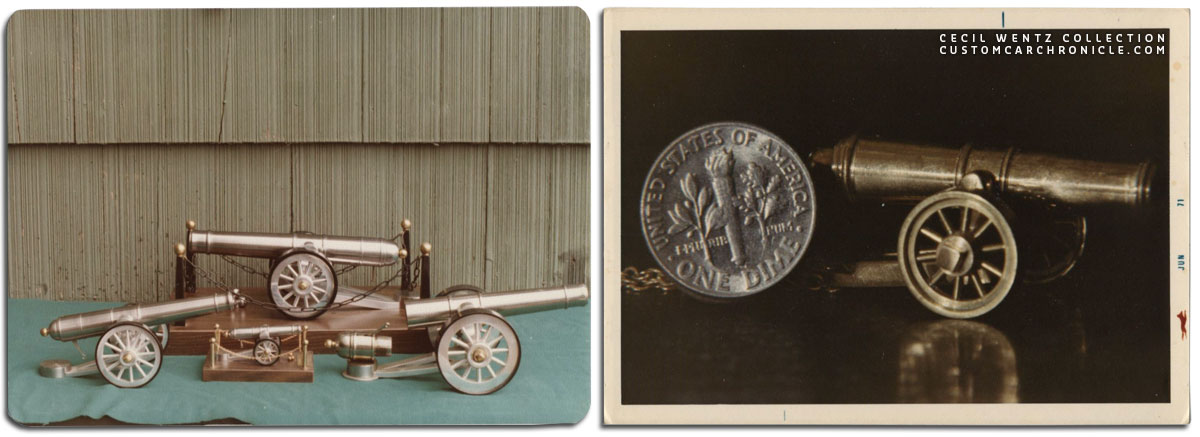 Some of Cecil’s miniature breech cannons he created.
Some of Cecil’s miniature breech cannons he created.
[divider]
The Sheridan papers she sent also included articles on the successes of Wentz and his friends in the sprint car circuit across Wyoming and Nebraska. His first racer was a black speedster with the unmistakable nose of the 1936 Terraplane he had used for power. The orange No. 3, with the same hopped up engine, but a distinctive sprint car body, would not arrive until later. I told her my most precious custom car memory involved a sprint car race her dad had put on at the Sheridan fairgrounds. As I commented on an earlier CCC article, it was there in the infield that I spotted a 39-40 Ford or Mercury four-door convertible, chopped, speedboat stance, full fenderskirts, and painted a wonderful metallic lime green.
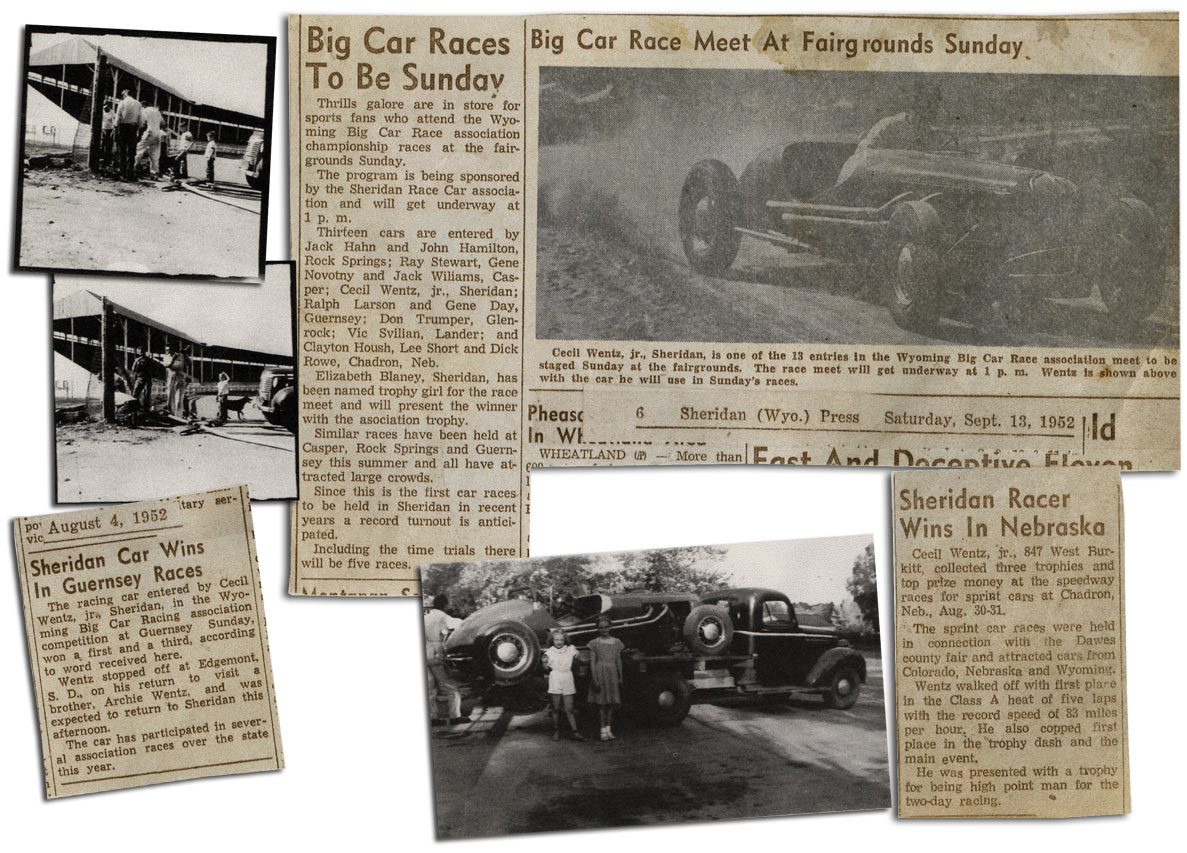 Some of the Sheridan News Paper articles on and family album photos of Cecil and his first racer racing at the Sheridan fairgrounds.
Some of the Sheridan News Paper articles on and family album photos of Cecil and his first racer racing at the Sheridan fairgrounds.
[divider]
 Cecil racing his first racer, which was a black home built speedster with a 1936 Hudson Terraplane hood and grille.
Cecil racing his first racer, which was a black home built speedster with a 1936 Hudson Terraplane hood and grille.
[divider]

“Oh! I have the poster and newspaper reports for that race,” she exclaimed. “And pictures of us kids cleaning the stands, picking up trash and fixing fences after the race. Clarence Newton (Jersey Creamery) brought a dairy truck up with treats and helped to haul off our hard work!”
I had thought I was about 8 or 10 at the time, but instead it turns out I was 12. My dad had taken me there September 14, 1952 after my older sister had gotten married. When I shared this with Conquistador, Gary “Slim” Richards, he said, “I was at that very same race, too! The Wentz Carburetor Special. I’ll never forget the sound of that Graham supercharged motor. Like nothing I’d ever heard before. Like a Ferrari.”
And I never forgot that lime green “California” custom phaeton!
Wentz family history.
So, who was this man Cecil Wentz, gifted gearhead and mentor to the Conquistadors and…through them… to generations of car guys far and away? Like many, he was a product of a rich melting pot heritage. His father joined migrating Missourians to northern Wyoming with the opening of the railroad. “Dad’s Dad Cecil Sr. was born in Soleville, Missouri, close to St. Louis and Wentzville, Missouri,” Cecelia explained. “He came to Sheridan to be on the railroad. Our Grandma Wentz’s Dad brought them to Sheridan in 1894. Their household goods was the first to be shipped by rail in Wyoming. I have the bill of lading. Also an article in the Omaha (Nebraska) paper outlining the wonderful county of Sheridan. It is dated just before they moved so feel that it is what made the decision. He was a master carpenter. Lots of stories there. He came to America from Berlin and our great grandmother from Sussex, England, via Ontario, Canada.”
 Early train, Wyoming and the original Sheridan railroad depot.
Early train, Wyoming and the original Sheridan railroad depot.
[divider]
Cecil’s mother’s side is steeped in Polish culture. “Our Grandfather was Franza Labaj. He Americanized by going to Frank Labay. Grandma’s maiden name was Wawrzacz.” Both families came from Austrian Silesia, what later was to be the southwestern corner of Poland. They sought a new life, through opportunities afforded by the coal mines of Sheridan County. It was the needs of the same railroad for coal, the “black diamond” that had opened these opportunities to migrant families.
It wasn’t all it had been promoted to be. One immigrant noted, “I came to American because I heard the streets were paved with gold. When I got here, I found out three things: First, the streets weren’t paved with gold; second, they weren’t paved at all; and third, I was expected to pave them.”
 Color post card of Sheridan in 1912 and another street view from 1909, no gold paved streets here.
Color post card of Sheridan in 1912 and another street view from 1909, no gold paved streets here.
[divider]
For Rosalie Labay Wentz’s parents and scores more of kindred spirit, it was a chance worth the risk, and the lofty Bighorn Mountains reminded them of their homeland. Polish immigration to Sheridan County recently has been chronicled in “We Are One Family”, a labor of love by the cousins Karen Ballek and Leon Washut, themselves immigrant descendents like the sisters Wentz.
The “American Dream”. Cecil Wentz could have been the poster child for the Industrial Revolution as it made its way onto the Western frontier of America. He and his brothers Nathaniel and Archie were into anything a motor could propel forward, backward, or even sideways. He and Nathaniel opened the first Harley Davidson dealership in town, and soon were racing motorcycles with Jack and Dick Yentzer (later WWII flying aces). The frequent flier miles between the Wentz and Yentzer properties were to become well-traveled by the local police. Warning tickets and winks, the daughters recalled, over the years.
“You mentioned his runs on Goose Creek,” Cecilia Wentz wrote, “and that reminded me of a story. Not all of the neighbors appreciated his driving. Someone called the cops on him, and one showed up at the house and told him they were going to give him a ticket for no license plate, no headlights, no fenders, no side mirrors and probably more that I can’t remember. The cop said, but I’ll let you off with a warning, just don’t do it again. All the cops brought their cars to him to fix, so they liked him.”
Where Wentz took his cars out on trial runs up Big Goose creek road later would be the scene of Jack Bushmaker’s infamous collision with a cottonwood tree in his chopped custom ’47 Chevy coupe, Purple Burp (See “Requiem for Purple Burp” article on CCC).
The Harley Davidson venture came to an abrupt and tragic end, with Nathaniel’s death in a motorcycle crash in 1940, very near where this Conquistador’s first custom car dreams were dashed on Massacre Hill (see Confessions of a Conquistador, Part One).
In the Post-WWII years, Cecil shifted his need for speed to the growing sport of jalopy racing, and for greater adrenalin rush, on to sprint cars. From a job as a mechanic at the local Ford dealership, he followed his own American dream, hanging the ”Wentz Auto and Machine Shop” sign above his home garage. Arthritis forced the family move to California in 1957. From all the inventiveness he exhibited, its fun to speculate just how far his creative genius might have taken him with the right connections.
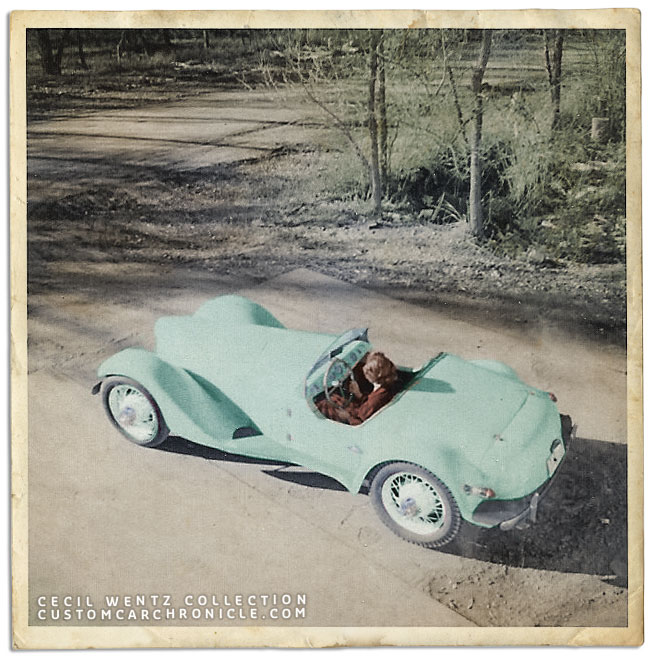 Colorized photo of the Wentz roadster how it looked painted 1Shot robins egg blue.
Colorized photo of the Wentz roadster how it looked painted 1Shot robins egg blue.
[divider]
What Cecil Wentz did leave was beyond measure. Most probably he didn’t even know much of the ripples from that rock he tossed into Life’s pond. It was the gift of Inspiration. Inspiration to a small group of teen-agers who gathered in his garage, created things in their own ways, and decided to form a car club. When I look at one of those funky Conquistador plaques, I don’t just see a piece of pot metal roughly cast in a high school shop class. I see the living legacy of Cecil Wentz. It is the true Spirit of “What Goes Around, Comes Around”, courtesy of Rik Hoving, customcarchronicle.com.

[divider]
(this article is sponsored by)
![]()

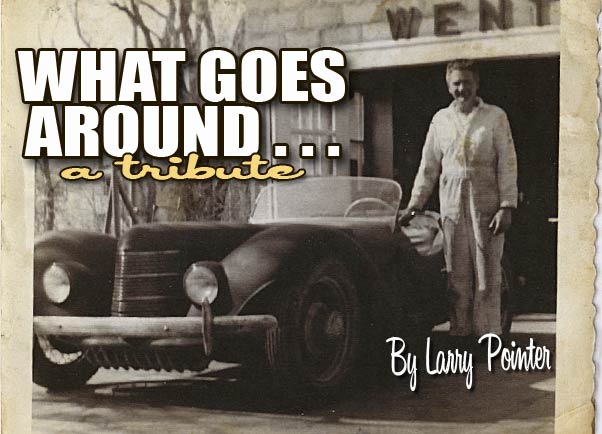
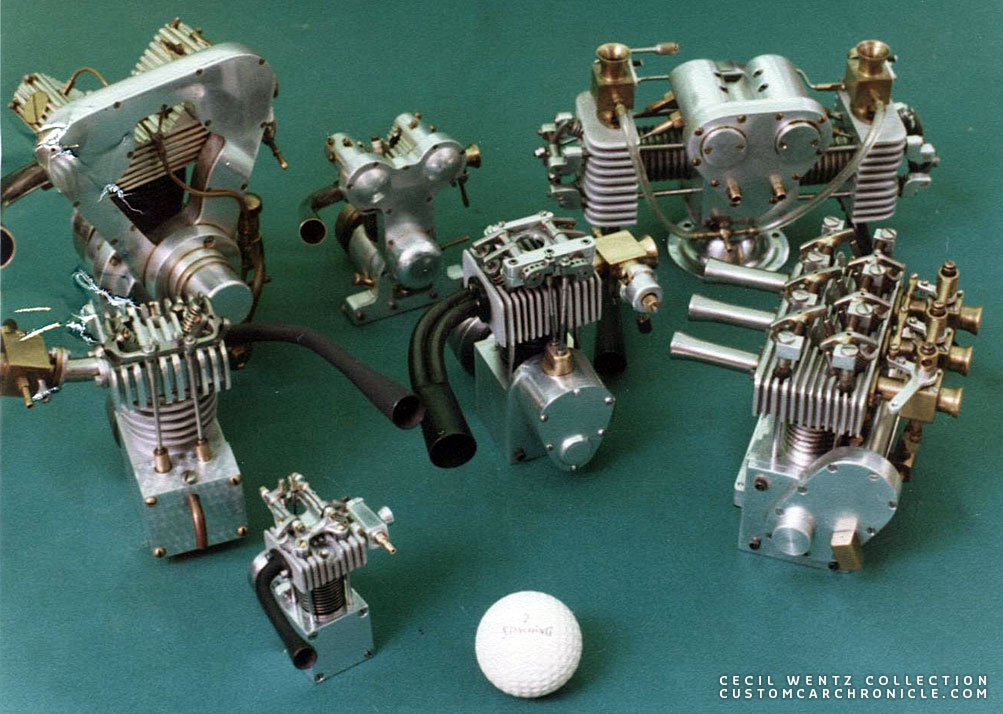





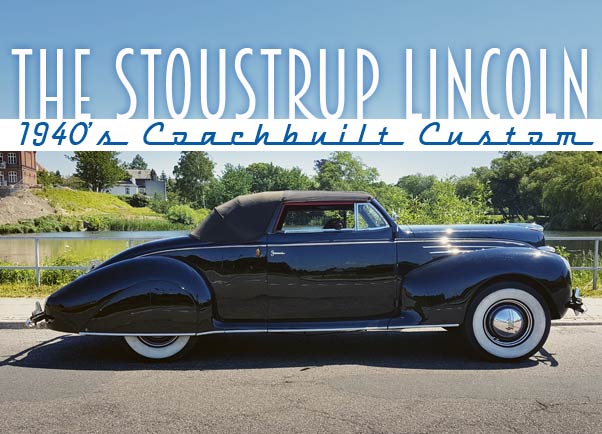
That was… wow… just bloody awesome! Best article so far by Mr. Pointer. My respect for my Sheridan predecessors grows daily, and this was massively insightful about the gents I look up to and whom they looked up to. Tremendous!
Great article.
As Mr Pointer says. It truly is a small world thanks to the internet.
Torchie
Gawrsh, guys. The last time I recall being called “Mr. Pointer” was when I tried my first bareback bronc ride, at a practice my college kids were having. It went something like this: “Mr. Pointer, if you could get up, we can shut the gate.”
Just Larry. Thanks, and thanks to Rik for again doing his magic for us.
Things often go back, from Wentz it came ! Yes a very, very special story here.
Great article, thanks for this!
great story larry an rik,